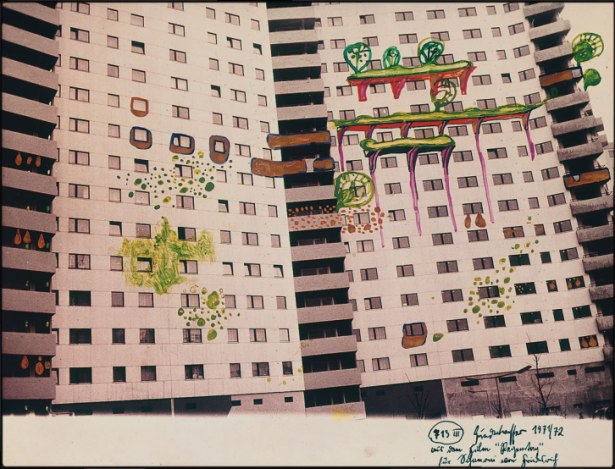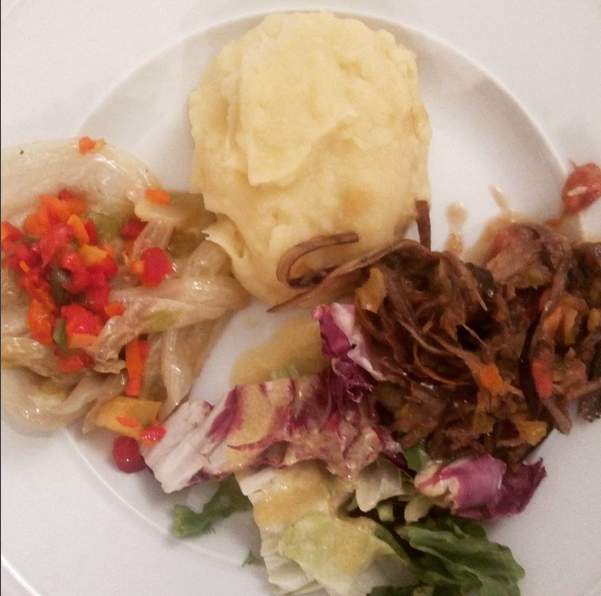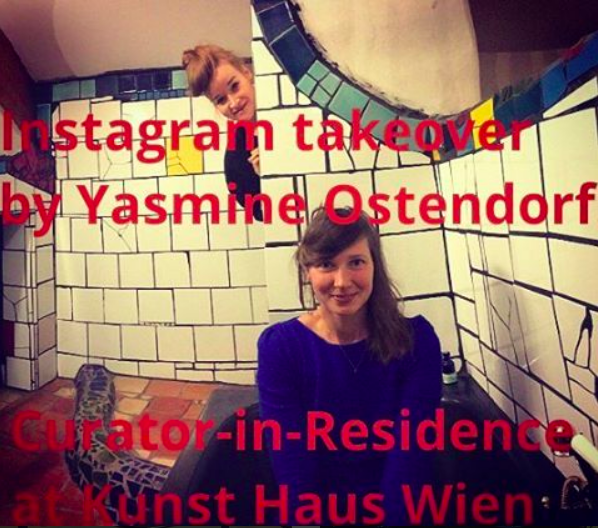This post comes from the Artists and Climate Change Blog
Author:Â Yasmine OstendorfÂ

Friedensreich Hundertwasser (1928-2000) was a rather eccentric Austrian artist, known for his colourful paintings and Gaudi-esque architecture. His work can be found all over the world, brightening up streets from Vienna to Osaka. He was unconventional and rebellious and stated that “the straight line leads to the downfall of humanity.†He applied this rule to both his paintings as well as buildings, resulting in uneven floors and sometimes dangerously low ceilings. But the straight line wasn’t his only worry: he was an environmental activist concerned about our human relation to nature and addressing issues such as the quality of the air (“we are suffocating in our cities from poison and a lack of oxygenâ€) and dangers of nuclear power plants, through his art practice.

Use Public Transport – Save the City (1989), Hundertwasser
This month I’m staying in Hundertwasser’s original former apartment in Vienna, as Curator-in-Residence of Kunst Haus Wien. The apartment, located on top of the museum, is a true health and safety hazard (even the floors aren’t straight) but allows for a great insight into his work and philosophies. Hundertwasser believed that art has to be the bridge between the creativity of nature and creativity of man, and that art has to include nature and its laws. For Hundertwasser it means, amongst other things, that one should be able to hang out the window and change the exterior of a building as far as the arm can reach (I haven’t tried this yet) but it also means one should be surrounded by plenty of trees. From the house one should be able to see the trees from different perspectives. This is certainly the case in his own home; not only is there a rooftop garden, but the apartment is full of windows, large and small, from which you can peek outside, or to the other rooms. Hundertwasser stated the trees are also tenants of the apartment, and that their contribution towards the rent is actually much more valuable than any currency humans use. His ten-point manifesto celebrates the tree tenants, bringing oxygen and “the needed moisture to the city.â€

Hundertwasser’s healing suggestion for a residential building, 1971/72 – Application of Window right and Tree duty
Already in 1975, Hundertwasser was exploring the idea of a “humus toilet,†a do-it-yourself composting toilet that doesn’t use electricity, water, or chemicals. He also developed a water purification system for urine and waste water using aquatic plants such as cypress grass and water hyacinth. Though none of these innovations are installed in his apartment on top of the museum (unfortunately?), what you do notice is how all the organic forms and shapes in his home – even the uneven floors – create a very relaxed, warm and welcoming atmosphere, like you are in a boat. Maybe it wasn’t all so crazy to think that “being forced to walk on flat asphalt and concrete floors […] estranged from man’s age-old relationship and contact to earth, a crucial part of man withers and dies.â€Â According to Hundertwasser, living in these “designers’ officesâ€Â has “catastrophic consequences for the soul, the equilibrium, the well-being and health of man.â€

Hundertwasser’s water purification system
Being in residence in his house allows me to learn more about this curious persona and see what his legacy means to contemporary artists in Vienna. To what extent are these 70s and 80s rhetorics and aesthetics still relevant? This month, in collaboration with curator Jade Niklai, I will be interviewing pioneering artists, architects, designers, thinkers, curators and other creative professionals focused on the key environmental issues of our time: flooding, drought, ecocide, extinction of species, loss of biodiversity, waste, ocean acidification, climate change, energy transition, resource use; and the notion of the Anthropocene. The aim of the research is to map existing efforts by Austria’s cultural communities, facilitate their amplification abroad and develop an ambitious exhibition on the topic.
My first visit was to Brazilian artist Kadija de Paula, in residence at art space M21 in Vienna. Dinner on Saturday with the artist meant eating what she and her partner Chico found during a local dumpster-diving expedition. They found a lot of bananas which meant we ate both banana compote as well as a banana peel stew. It was surprisingly delicious! During their month-long residency they take up the challenge to live and work with found resources, food and materials, avoiding the use of resources that should not have been created or that will soon be depleted. They will research habits and processes of disposal, recycling and social assistance in Vienna, and collect found objects in the house (which was already getting a bit full after one week in town!). But sharing the food together, surrounded by beautiful objects, you could not not think about our ridiculous obsession with buying and consuming. It was probably my most sustainable meal ever and I think Hundertwasser would have been proud.

Banana peel stew, photo by Yasmine Ostendorf
Diving into the life and work of Hundertwasser shows that artists working with environmental issues is nothing new, nothing “hip†and unfortunately it hasn’t become less urgent. Hundertwasser was a visionary artist expressing his concerns about nature almost 50 years ago and sadly we are still dependent on fossil fuels, addicted to consuming and creating unsustainable amounts of waste. This month I hope to find many more inspiring examples by artists and hopefully will be eating more banana peels.
For the whole of January Yasmine Ostendorf is in residence at Kunst Haus Wien. The research forms the foundation for an exhibition in late 2017, to be presented in the framework of The Garage Gallery’s ongoing programme on the topic. Follow Yasmine Ostendorf in residence at Kunst Haus Wien via her Instagram take-over.

Artists and Climate Change is a blog that tracks artistic responses from all disciplines to the problem of climate change. It is both a study about what is being done, and a resource for anyone interested in the subject. Art has the power to reframe the conversation about our environmental crisis so it is inclusive, constructive, and conducive to action. Art can, and should, shape our values and behavior so we are better equipped to face the formidable challenge in front of us.
Go to the Artists and Climate Change Blog
Powered by WPeMatico


